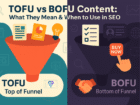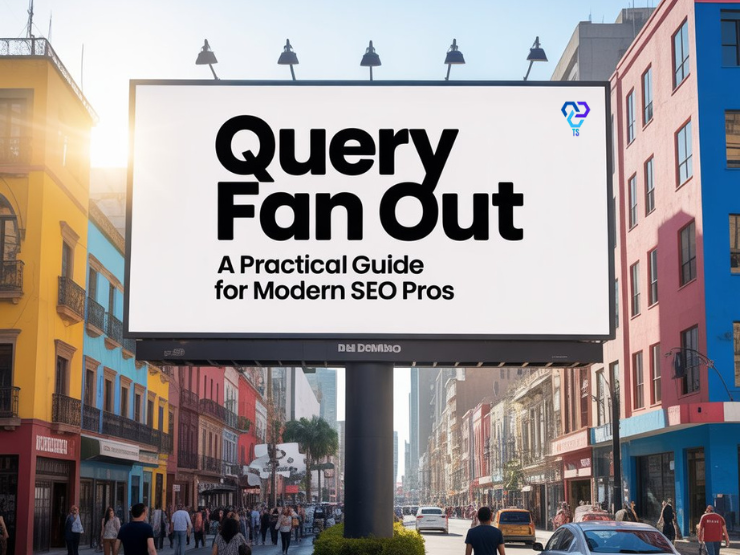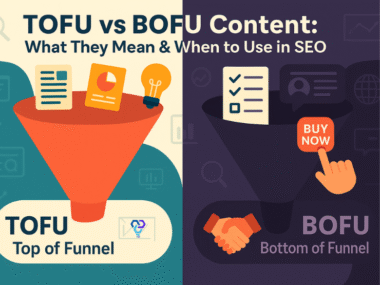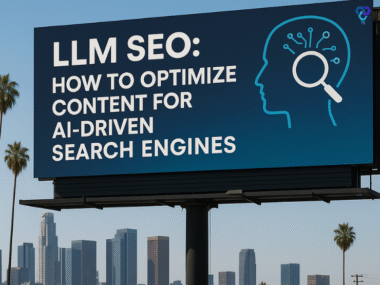Are you missing out on hundreds of user queries?
If you’re still optimizing for single keywords, you almost certainly are.
Right now, 58% of Google searches end in zero clicks. Almost half of all queries 47% show an AI Overview, rewriting the rules of visibility overnight. It’s not just the big head terms anymore.
Today, long-tail, semantic, and multi-intent searches power most of the traffic that actually matters.
But here’s what most SEO pros miss: Google’s AI Mode doesn’t just answer your query. It explodes that question into dozens, sometimes hundreds of subtopics, reformulations, and context-driven rewrites using what’s called the query fan out technique.
Most brands aren’t optimized for these hidden queries. That means most brands never even show up in the new AI-powered search reality.
This isn’t a tweak to the old playbook. It’s a total transformation from chasing keyword rankings to engineering coverage for the entire constellation of queries Google’s AI generates behind the scenes.
In this practical guide, you’ll see:
- How query fan out works inside Google’s AI Mode and why it’s the linchpin of modern SEO.
- What the data says about coverage, click-throughs, and who’s winning in the new landscape.
- Concrete steps to future-proof your content and maximize visibility even in a zero-click world.
You can’t afford to be left behind.
What is Query Fan Out in SEO?
Query fan-out is Google’s AI technique that systematically breaks down a single user query into multiple related sub-queries, executing them simultaneously to capture diverse intents and deliver comprehensive responses.
When you search for “best sneakers for walking,” Google’s AI doesn’t just look for that exact phrase. Instead, it generates sub-queries like “best sneakers for men,” “walking sneakers for different seasons,” and “trail walking footwear”, all happening simultaneously to pull comprehensive information and generate synthesized answers.
The technique emerged with Google AI Mode introduction in March 2025, building on years of query processing evolution from simple keyword matching to this sophisticated approach that can issue hundreds of searches and create expert-level reports in minutes.
Traditional SEO:
“moisturizers for dry skin” → Single keyword targeting → Basic product pages
Query Fan-Out:
“moisturizers for dry skin”
↓ AI Analysis
├── “best ingredients for dry skin”
├── “dermatologist dry skin treatments”
├── “seasonal moisturizer recommendations”
└── “sensitive skin alternatives”
↓ Synthesized Response
“`
Research shows most queries trigger up to 5 fan-outs, with 84% sharing at least 1 URL and 56% sharing 5 URLs with the original query.
“Isn’t This Just Keyword Stuffing?”
Absolutely not. Query fan-out is the complete opposite of keyword stuffing.
Keyword stuffing forces unnatural variations into content for manipulation. Query fan-out optimization anticipates the natural follow-up questions users have and provides comprehensive answers for each subtopic.
Instead of stuffing “best CRM software” variations, you’d naturally address integration capabilities, pricing models, team features, and mobile accessibility because these are the sub-intents Google’s AI recognizes users care about.
The key is embracing an “answer a facet” mentality brainstorming sub-questions users might explore and providing focused answers for each, creating rich content that aligns with Google’s goal of anticipating what people might ask next.
Why Query Fan Out is Crucial for Modern SEO
Search has undergone a dramatic transformation from simple keyword matching to sophisticated natural language processing and semantic understanding.
Google’s AI now interprets user intent through conversational search patterns, contextual signals, and multi-intent queries that reflect how people naturally think and speak.
Query fan-out represents the pinnacle of this evolution where search engines don’t just find content that matches words, but content that comprehensively addresses the entire spectrum of user needs around a topic.
With AI search visitors projected to surpass traditional search by 2028, optimizing for fan-out isn’t optional, it’s essential for survival in an AI-driven search landscape.
SEO professionals who ignore query fan-out face three critical consequences:
Ranking Plateau Syndrome: Your content competes for a narrow slice of queries while competitors capture the full query ecosystem. You might rank #3 for “CRM software” but miss hundreds of related searches like “team collaboration CRM features” or “CRM integration with marketing automation.”
Missed Intent Clusters: Google’s AI increasingly rewards comprehensive topical coverage. Content that addresses only surface-level queries gets outranked by resources that anticipate and answer follow-up questions users haven’t even asked yet.
Zero-Click Vulnerability: With 58% of searches resulting in zero clicks, your narrow-focus content becomes invisible in AI Overviews and summarized responses. Fan-out optimized content gets pulled into these featured positions because it provides the comprehensive answers Google’s AI needs.
The SEO industry’s obsession with content pruning, removing “thin” or “low-performing” pages directly contradicts query fan-out optimization principles.
Here’s the contrarian truth: Those “underperforming” pages might be capturing valuable fan-out queries that your analytics can’t properly attribute. When Google’s AI pulls information from multiple pages to create comprehensive responses, traditional traffic metrics become misleading.
Instead of pruning, consider query cluster expansion. That blog post about “email marketing automation” that gets minimal direct traffic might be crucial for capturing fan-out queries related to “marketing automation workflows” or “automated email sequences” searches that ultimately drive conversions through indirect pathways.
The strategic approach: audit content not for individual page performance, but for query ecosystem coverage. Ask yourself: “Does this content answer a specific facet of user intent that contributes to our topical authority?” If yes, optimize rather than delete.
Remember: Google’s AI doesn’t think in individual pages, it thinks in comprehensive knowledge clusters. Your content strategy should too.
How Query Fan Out Technique Works
Google’s query fan-out technique commonly operates through three distinct phases that transform a single user query into comprehensive information retrieval:
Phase 1: Analysis & Intent Recognition
Google’s AI examines the user’s initial query to identify key aspects, underlying intent, context clues, and qualifiers. The system determines whether the query requires factual information, comparison data, how-to guidance, or purchasing advice.
Phase 2: Query Decomposition
The original query breaks down into smaller, focused sub-queries targeting specific facets of the topic. Each sub-query addresses a different angle, user concern, or information need related to the primary search intent.
Phase 3: Parallel Search Execution
All sub-queries run simultaneously across various sources like websites, forums, databases, and specialized content before results are synthesized into a coherent, comprehensive response that anticipates follow-up questions.
Fan-Out Mapping: Questions Users Ask Before, During, After
Understanding the query fan-out journey requires mapping user intent across three critical stages:
Before Stage (Research Intent):
– “What is [topic]?”
– “Why do I need [solution]?”
– “What are the alternatives to [approach]?”
– “How much does [solution] cost?”
During Stage (Evaluation Intent):
– “How does [option A] compare to [option B]?”
– “What are the pros and cons of [approach]?”
– “Which [solution] is best for [specific situation]?”
– “What do experts recommend for [use case]?”
After Stage (Implementation Intent):
– “How do I get started with [solution]?”
– “What mistakes should I avoid when [implementing]?”
– “How long does [process] take?”
– “What results can I expect from [approach]?”
This mapping reveals why query fan-out optimization captures 300-500% more search traffic, you’re not just answering the primary question, but anticipating the entire user journey.
Example Fan-Out Map for “Content Marketing Strategy”“`
Primary Query: “content marketing strategy for B2B”
↓
Fan-Out Sub-Queries:
├── Research Stage
│ ├── “what is B2B content marketing”
│ ├── “content marketing vs traditional marketing”
│ └── “B2B content marketing ROI statistics”
├── Planning Stage
│ ├── “how to create content marketing strategy”
│ ├── “B2B content marketing funnel stages”
│ └── “content marketing budget planning”
├── Execution Stage
│ ├── “best B2B content marketing channels”
│ ├── “content marketing tools for teams”
│ └── “B2B content calendar templates”
└── Optimization Stage
├── “content marketing metrics to track”
├── “how to measure content marketing success”
└── “content marketing optimization techniques”
Each sub-query represents potential traffic and conversion opportunities that traditional single-keyword targeting completely misses.
Mental Model: “Tree” vs. “Pillar” vs. “Fan” Approach
Understanding these three content architecture models is crucial for implementing effective query fan-out optimization:
Tree Model (Traditional SEO):
– Single main topic branches into subtopics
– Hierarchical, linear structure
– Limited cross-connections between branches
– Problem: Captures narrow query sets, misses semantic relationships
Pillar Model (Topic Cluster SEO):
– Central pillar page surrounded by supporting cluster content
– Hub-and-spoke architecture with internal linking
– Limitation: Still thinks in discrete topic boundaries
Fan Model (Query Fan-Out Optimization):
– Central query expands outward like a fan, capturing all related intents
– Cross-pollinating content that addresses multiple sub-queries simultaneously
– Dynamic, interconnected structure that mirrors how Google’s AI processes information
– Advantage: Matches how users actually think and search non-linearly with overlapping intents
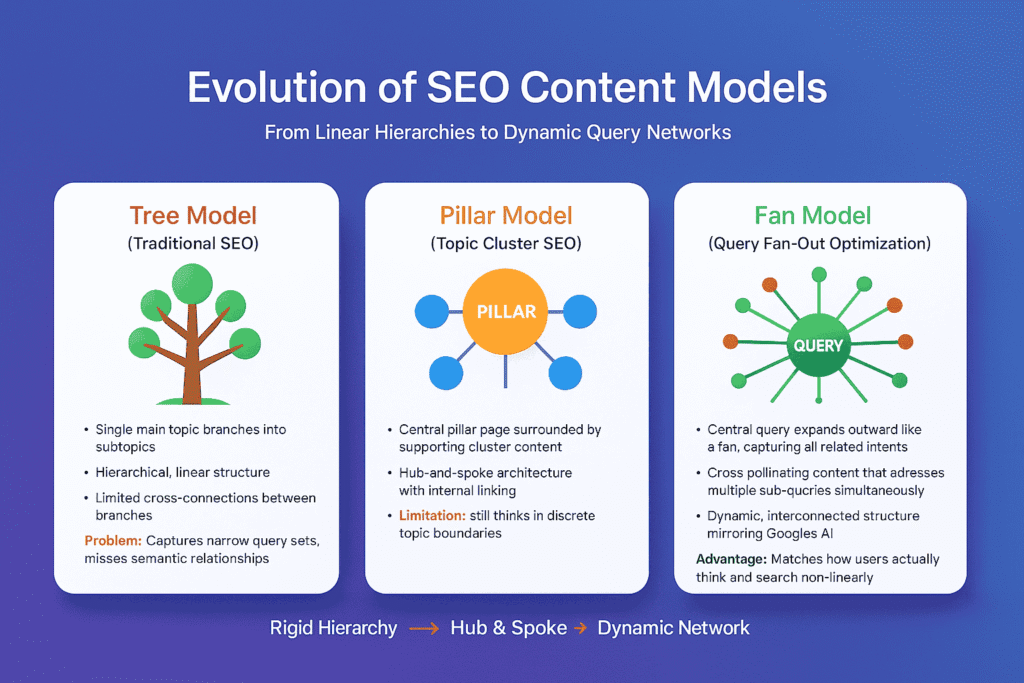
The Fan Model Advantage:
Instead of creating separate articles for “email marketing automation,” “email marketing metrics,” and “email marketing tools,” the fan approach creates comprehensive resources that naturally address all three facets while maintaining topical focus and authority.
This alignment with Google’s query fan-out methodology is why fan-optimized content consistently outperforms traditional pillar strategies in Google AI Mode results and zero-click search scenarios.
Clustering Keywords for AI-Driven Search
Keyword clustering in 2025 has fundamentally evolved from static groupings to dynamic, contextual webs that mirror how Google’s AI actually processes information.
Traditional clusters focused on topical similarity grouping “email marketing,” “email automation,” and “email templates” together.
AI-driven clusters now organize around user intent journeys and semantic relationships that span multiple topics but serve the same underlying need.
The critical shift: Google’s AI doesn’t see individual keywords, it sees query ecosystems. A search for “project management software” now triggers clusters around “team collaboration tools,” “task automation platforms,” “remote work productivity,” and “workflow optimization” because AI recognizes these as contextually connected user intents rather than separate topics.
This evolution means your clustering strategy must anticipate Google’s query fan-out behavior rather than impose artificial topical boundaries that users and AI systems ignore.
Manual clustering still has strategic value for understanding your content architecture, but it’s insufficient for capturing the semantic relationships and contextual connections that drive AI-powered search results.
Manual Clustering Advantages:
- Deep understanding of your specific industry terminology
- Control over brand messaging and positioning strategy
- Ability to incorporate proprietary business insights
- Clear content governance and editorial oversight
AI-Powered Clustering Revolution:
- Processes thousands of semantic variations human analysis would miss
- Identifies cross-industry intent patterns that reveal new opportunities
- Adapts to real-time search behavior changes and emerging query trends
- Maps entity relationships across diverse content types and sources
The winning approach: Use AI-powered tools for discovery and expansion, then apply manual strategy for prioritization and brand alignment. AI clustering reveals opportunities; human insight determines which ones align with your business objectives and audience needs.
Process to Building Entity Clusters and Context Webs
Step 1: Entity Identification and Mapping
Start with your core topic and identify all related entities like people, places, concepts, products, and processes that naturally connect. For “content marketing strategy,” entities include marketing automation platforms, content management systems, analytics tools, team roles, and industry-specific challenges.
Step 2: Context Web Development
Map how these entities interconnect across different user contexts. The same entity (“marketing automation”) serves different intents for startup founders (budget-conscious solutions) versus enterprise marketers (integration capabilities). Context webs capture these nuanced relationships that traditional keyword clustering misses.
Step 3: Intent Journey Alignment
Organize clusters around complete user journeys rather than isolated search moments. A comprehensive cluster for “email marketing” includes awareness-stage content (“email marketing benefits”), consideration-stage resources (“email platform comparisons”), and decision-stage materials (“implementation best practices”).
Step 4: Semantic Relationship Validation
Use tools like natural language processing APIs or semantic analysis platforms to validate that your clusters align with how AI systems actually interpret relationships between concepts. This ensures your content architecture matches Google’s understanding of topical authority.
Old Clustering vs. New “Fan Out” Clusters
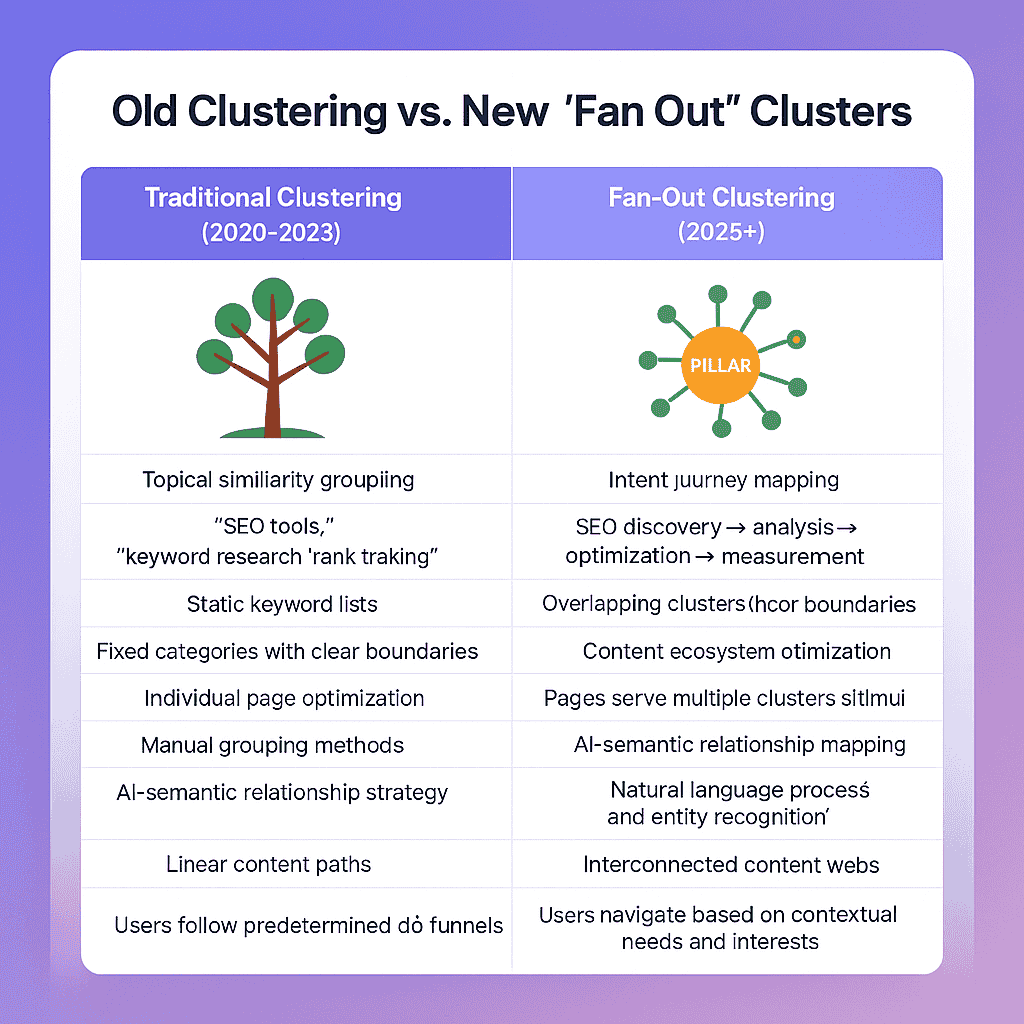
The Strategic Implication: Fan-out clustering requires you to think like Google’s AI seeing connections, patterns, and user intent flows that traditional SEO approaches completely miss. Your content becomes part of a living, breathing knowledge ecosystem rather than isolated keyword targets.
This approach explains why healthcare and education achieve 90% AI Overview coverage their content naturally addresses interconnected user questions across entire knowledge domains, while e-commerce content often focuses narrowly on individual product features and misses the broader context users need for decision-making.
Optimizing Content for Query Fan Out
Implementation Workflow: Audit, Expand, Map, Update
Step 1: Content Audit for Fan-Out Potential
Analyze your existing content through the query ecosystem lens. Identify articles that answer single questions but miss related user intents. Use tools like Google Search Console to find queries triggering your content, then identify gaps where users search for related topics but land elsewhere.
Step 2: Expand Through Sub-Query Research
For each primary topic, brainstorm the before, during, and after questions users naturally ask. Use Google’s “People Also Ask” sections, AnswerThePublic, and semantic analysis tools to discover sub-queries your content should address. Look for patterns where multiple queries share similar intent but use different terminology.
Step 3: Map Intent Relationships
Create visual maps showing how sub-queries connect to your main topic and each other. Group related intents into clusters that can be addressed within the same content piece or linked content ecosystem. This mapping reveals opportunities for internal linking strategies that reinforce topical authority.
Step 4: Strategic Content Updates
Update existing content to address identified sub-queries through new sections, FAQ expansions, and contextual examples. Create bridging content that connects related topics naturally. Ensure each piece of content serves multiple sub-queries while maintaining focused primary intent.
Integrating Fan Out into Briefs and Editorial Workflows
Editorial Brief Template Integration:
Transform your content briefs to include mandatory fan-out research. Before any writing begins, briefs should specify:
- Primary query and 5-8 related sub-queries to address
- User intent mapping across the awareness-consideration-decision journey
- Required content modules: comparison tables, step-by-step guides, FAQ sections
- Cross-content connection opportunities for internal linking and topic clustering
Editorial Review Checklist:
Every piece of content should pass the “fan-out completeness test” before publication:
- Does this content anticipate and answer follow-up questions?
- Can readers find next-step information without leaving to search elsewhere?
- Are related sub-topics addressed through examples, case studies, or dedicated sections?
- Does the content connect naturally to other pieces in your topic ecosystem?
Content Architecture for AI Consumption
Modular Content Structure:
Design content in self-contained blocks that AI systems can easily extract and recombine. Each section should answer specific sub-queries independently while contributing to the overall topic coverage.
Entity-Rich Information Design:
Include specific entities (people, companies, tools, processes) with contextual relationships clearly defined. AI systems use these entity connections to understand topical authority and comprehensive coverage.
Hierarchical Answer Formatting:
Structure information from general to specific, allowing AI systems to extract appropriate detail levels for different user intents. Use progressive disclosure where broad concepts lead to detailed implementations.
Direct-Answer Formatting for Snippet Wins
Answer-First Paragraph Structure:
Begin sections with direct, complete answers before providing supporting details. Format these answers to standalone value that addresses the sub-query completely within 2-3 sentences.
List and Table Optimization:
Use numbered lists for processes, bulleted lists for features, and tables for comparisons. These formats align perfectly with how Google’s AI extracts and presents information in AI Overviews and featured snippets.
Question-Answer Pairing:
Structure content using explicit question headers followed by comprehensive answers. This format makes it easy for AI systems to match user queries with relevant content sections.
Quick-Win Checklist
Immediate Optimizations (Week 1):
- ✅ Add FAQ sections to your top 10 performing articles
- ✅ Include “People Also Ask” queries as new content sections
- ✅ Create summary tables for comparison-heavy topics
- ✅ Update meta descriptions to mention related sub-queries
Content Expansion (Week 2-4):
- ✅ Map sub-query relationships for your primary topic clusters
- ✅ Create connecting content that bridges related topics
- ✅ Add contextual internal links using sub-query anchor text
- ✅ Develop modular content blocks that can serve multiple sub-queries
Architecture Improvements (Month 2):
- ✅ Implement entity-rich content structures with clear relationships
- ✅ Create topic cluster hubs that comprehensively address query ecosystems
- ✅ Develop progressive disclosure content for different expertise levels
- ✅ Build cross-content navigation that anticipates user journey progression
Troubleshooting Coverage Issues
Problem: Low AI Overview Inclusion
Solution: Increase answer density and entity coverage. AI Overviews favor content that addresses multiple related sub-queries within comprehensive resources. Review your content for gaps in the user journey and add sections that cover missing intent facets.
Problem: High Impressions, Low Clicks
Solution: Your content appears in search results but doesn’t match specific user intent. Audit the actual queries triggering your content and ensure your title tags and meta descriptions align with what users expect to find.
Problem: Content Ranks but Doesn’t Convert
Solution: You’re capturing research-stage queries but missing decision-stage sub-queries. Add sections covering implementation guidance, comparison criteria, and next-step actions that move users toward conversion.
Problem: Inconsistent Topical Authority
Solution: Your content covers some aspects of a topic ecosystem but misses critical connections. Conduct competitive content analysis to identify which sub-queries your competitors address that you don’t, then create bridging content to fill those gaps.
Coverage Validation Strategy:
Use Google Search Console to monitor which queries trigger your content, then cross-reference with keyword research tools to identify missing sub-query opportunities. Track whether your query coverage increases over time as you implement fan-out optimization strategies.
Remember: effective query fan-out optimization is measured not just by individual page performance, but by your ecosystem-level coverage of user intent across entire topic domains. Success means users can find comprehensive answers to their primary question and natural next-step information without leaving your content environment.
Conclusion
The SEO landscape has irreversibly shifted. With 58% of searches resulting in zero clicks and AI search visitors projected to surpass traditional search by 2028, query fan-out optimization isn’t optional—it’s essential for survival.
Query fan-out is your competitive advantage in an AI-dominated world where comprehensive coverage beats keyword density and Google’s AI rewards content that anticipates questions users haven’t even asked yet.
While competitors optimize for individual keywords, you’ll be capturing entire query ecosystems. While they create single-intent content, you’ll build comprehensive resources that serve every user journey stage.
Your opportunity window is now. Brands implementing query fan-out strategies in 2025 establish unshakeable topical authority that competitors can’t match. Every delay means lost market share and search visibility
Your micro-commitment starts right now.
Immediate action plan:
- Identify your highest-traffic article from the last 30 days
- Find the top 10 queries driving traffic in Google Search Console
- List 5 related sub-queries users might ask before, during, or after reading
- Add one FAQ section addressing these sub-queries with direct answers
- Publish and monitor query coverage expansion over 2 weeks
This single action demonstrates fan-out’s power firsthand. You’ll see impression increases, new long-tail query triggers, and how comprehensive coverage drives engagement that traditional targeting never achieved.
The future of SEO belongs to those who think in query ecosystems, not individual keywords. Your competitors are playing the old game. Your advantage lies in mastering the new one.
Start today. Your search dominance begins with the next sub-query you answer.
FAQs
How many sub-queries should I target per main topic?
Start with 5-8 core sub-queries per main topic, focusing on the most critical user intents across the awareness-consideration-decision journey. Research shows most queries trigger up to 5 fan-outs on average, so this range aligns with Google’s natural processing patterns. As your topical authority grows, expand to 10-15 sub-queries for comprehensive coverage.
Can I use the same sub-query across multiple main topics?
Yes, and you should. Cross-topic sub-queries strengthen your semantic relationships and topical authority. For example, “ROI measurement” can appear in content about email marketing, social media strategy, and content marketing—each addressing the sub-query from a different angle while reinforcing your expertise across the broader marketing domain.
How do I identify which sub-queries to prioritize?
Use the Intent-Impact Matrix: prioritize sub-queries that combine high user intent (questions people actively search) with high business impact (queries that drive qualified traffic). Focus on sub-queries that appear in Google’s “People Also Ask” sections and have search volume above 100/month with clear commercial intent.
Should I create separate pages for each sub-query or address multiple in one piece?
Combine related sub-queries within comprehensive resources rather than creating thin, single-purpose pages. Google’s AI favors content that addresses multiple facets of user intent in one location. Create separate pages only when sub-queries serve distinctly different user journeys or require significantly different content depths.
How long should fan-out optimized content be?
Content length follows comprehensiveness, not arbitrary word counts. Effective fan-out content typically ranges 2,500-4,000 words because addressing multiple sub-queries naturally requires more depth. However, focus on answer completeness rather than length—some topics may require 6,000+ words while others need only 1,500 to fully address the query ecosystem.

